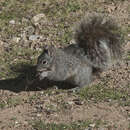en
names in breadcrumbs


The Arizona gray squirrel is a harmless rodent that co-exists peacefully with humans and other animals in a highly circumscribed habitat. Its future in the United States depends on the preservation of the canyon forests where it makes it home.
Perception Channels: tactile ; chemical
The population of Arizona gray squirrels in the United States is fairly small, a situation that may be connected to competition from Sciurus aberti, a hardier squirrel and a close relative. The United States Department of the Interior, Fish and Wildlife Service classifies the Arizona gray squirrel as a "Category 2" species, which is reserved for taxa that may be eligible for threatened or endangered status. In Mexico, S. arizonensis has suffered severe habitat loss due to logging and the clearing of forests for agricultural use. The squirrel is rare in Mexico and is considered a threatened species in the that country. (Best and Riedel 1995)
IUCN Red List of Threatened Species: data deficient
This species may be important as a disperser of tree seeds and the spores of mycorrhizal fungi.
Sciurus arizonensis may feed on a wide variety of vegetable material, including nuts, fruits, bark, berries, flowers, and fungi. The actual breadth of the diet depends on the availability of food sources and the particular geographic range of the animal. In New Mexico, S. arizonensis feeds almost exclusively on walnuts, supplemented by roots. In Arizona and Mexico, the gray squirrel eats walnuts, but also acorns, juniper berries, hackberries, pine seeds, and fungi. The diet of these squirrels is more varied on a seasonal basis as well. In late summer and early autumn, the Arizona- and Mexico-based squirrels take in insects and other animal matter. Walnuts are a staple for S. arizonensis regardless of geographic range, and several individuals often harvest these nuts in the same tree. Another dietary habit shared by all members of the species is the consumption of flower parts in late winter and early spring. This seasonal food source is thought to be linked to reproductive activity (see Reproduction). (Best and Riedel 1995)
Sciurus arizonensis occupies mountain ranges in central Arizona, western New Mexico, and Sonora, Mexico, along the U.S. border. (Best and Riedel 1995)
In Arizona, S. arizonensis occurs in dense, mixed-broadleaf communities of riparian-deciduous forest. Usually, the species is restricted to elevations of 1,500 to 1,900 meters above sea level. Favored habitats are groves of old cavity-prone Arizona sycamores and other large deciduous trees. In New Mexico, the squirrel is confined to deep canyons with water, where black walnuts and acorns are abundant. In Mexico, the squirrel occupies riparian forests at lower elevations than does its Arizona cousin. (Best and Riedel 1995) (Cockrum 1992) (Findley 1987)
Terrestrial Biomes: forest ; mountains
Known commonly as the Arizona gray squirrel, Sciurus arizonensis is gray in color throughout most of its upper body. Patches of yellow are sometimes present behind the ears. The tail is black dorsally and yellow to brown ventrally. The two sides of the tail are separated by white edging, and the underparts of the squirrel also are white. The squirrel's gray pelage darkens during the winter, and its underparts and feet are often stained from walnut juice (see Food Habits). Total body length for the species, including the tail, averages 21 inches. (Best and Riedel 1995) (Cockrum 1992)
Other Physical Features: endothermic ; bilateral symmetry
The onset of breeding activity in the Arizona gray squirrel is correlated with flower emergence and the inclusion of flower parts in the diet. It is theorized that the flower parts contain vitamin A and other vitamins that stimulate reproductive activity. Estrus occurs in females in April and early May. Mating chases also occur during this time, with several males pursuing a single female. Not all females breed each year. Gestation usually lasts about two months, and the litter size ranges from two to four offspring. (Best and Riedel 1995)
Key Reproductive Features: gonochoric/gonochoristic/dioecious (sexes separate); sexual